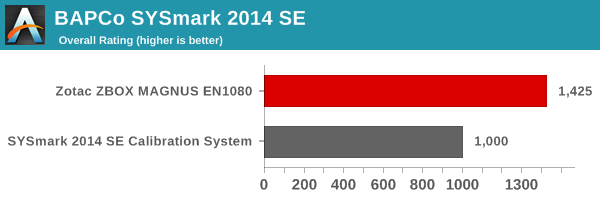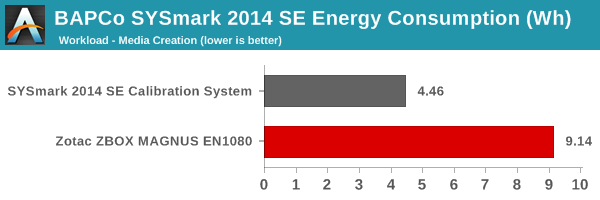Zotac ZBOX MAGNUS EN1080 SFF PC Review: A Premium Gaming Powerhouse
by Ganesh T S on December 19, 2016 8:30 AM ESTPerformance Metrics - I
The Zotac ZBOX MAGNUS EN1080 was evaluated using our standard test suite for gaming mini-PCs. Not all benchmarks were processed on all the machines due to updates in our testing procedures. Therefore, the list of PCs in each graph might not be the same. In the first section, we will be looking at SYSmark 2014 SE, as well as some of the Futuremark benchmarks.
BAPCo SYSmark 2014 SE
BAPCo's SYSmark 2014 SE is an application-based benchmark that uses real-world applications to replay usage patterns of business users in the areas of office productivity, media creation and data/financial analysis. In addition, it also addresses the responsiveness aspect - the user experience as related to application and file launches, multi-tasking etc. Scores are meant to be compared against a reference desktop (the SYSmark 2014 SE calibration system in the graphs below). While the SYSmark 2014 benchmark used a Haswell-based desktop configuration, the SYSmark 2014 SE makes the move to a Lenovo ThinkCenter M800 (Intel Core i3-6100, 4GB RAM and a 256GB SATA SSD). The calibration system scores 1000 in each of the scenarios. A score of, say, 2000, would imply that the system under test is twice as fast / better as the reference system.





SYSmark 2014 SE also adds energy measurement to the mix. A high score in the SYSmark benchmarks might be nice to have, but, potential customers also need to determine the balance between power consumption and the efficiency of the system. For example, in the average office scenario, it might not be worth purchasing a noisy and power-hungry PC just because it ends up with a 2000 score in the SYSmark 2014 SE benchmarks. In order to provide a balanced perspective, SYSmark 2014 SE also allows vendors and decision makers to track the energy consumption during each workload. In the graphs below, we find the total energy consumed by the PC under test for a single iteration of each SYSmark 2014 SE workload and how it compares against the calibration system.





The Core i7-6700-based MAGNUS EN1080 obviously performs far better than the ThinkCenter M800 with a Core i3-6100. However, the presence of a discrete GPU in the EN1080 drives up the energy consumption quite a bit compared to the calibration system. The benchmark numbers just prove that the ZBOX MAGNUS EN1080 is no slouch when it comes to business tasks, but, it makes no sense to purchase it just for that purpose. Gaming is the obvious focus, and we will be looking at the relevant benchmarks starting with the next sub-section.
Futuremark PCMark 8
PCMark 8 provides various usage scenarios (home, creative and work) and offers ways to benchmark both baseline (CPU-only) as well as OpenCL accelerated (CPU + GPU) performance. We benchmarked select PCs for the OpenCL accelerated performance in all three usage scenarios. These scores are heavily influenced by the CPU in the system. The Core i7-6700 is the most powerful CPU that we have evaluated in the SFF PC space, and we have not seen any GPU as capable as the GTX 1080 in this market segment till now. Therefore, it is no surprise that the ZBOX MAGNUS EN1080 comes out on top in all of the Futuremark benchmarks.



Miscellaneous Futuremark Benchmarks





3D Rendering - CINEBENCH R15
We have moved on from R11.5 to R15 for 3D rendering evaluation. CINEBENCH R15 provides three benchmark modes - OpenGL, single threaded and multi-threaded. Evaluation of select PCs in all three modes provided us the following results. As we saw in the Futuremark benchmarks, the ZBOX MAGNUS EN1080 easily comes out on top in all of the modes.













38 Comments
View All Comments
TheinsanegamerN - Tuesday, January 17, 2017 - link
I'm surprised zotac didnt contract with dell for the 330w brick.zenonu - Monday, December 19, 2016 - link
The bricks can sit on the floor and be ugly there. The desktop can sit on your desk, be functional, and take a minimal footprint. That said, two separate power bricks is clunky design and annoying for certain.Zak - Monday, December 19, 2016 - link
WTF with the retarted ads on Anandtech lately? Seriously? This is total garbage! Does not belong here.BrokenCrayons - Monday, December 19, 2016 - link
Advertisements are all targeted based on what the advertiser learns about you by mining your web activity and compiling relevant information. The ads I see, are intelligent and thoughtful. They attempt to market smart and helpful products because advertisers understand that I'm a discerning customer. If the advertisements you're seeing are conversely "retarted" that might say something about what you do on the Internet through your devices.Holliday75 - Monday, December 19, 2016 - link
LOLprisonerX - Monday, December 19, 2016 - link
There are ads on Anandtech?alphasquadron - Monday, December 19, 2016 - link
"The premium PC also needs to adopt the Alpine Ridge controller with Thunderbolt 3 / USB 3.1 Gen 2 support instead of the plain ASMedia ASM1142 solution."Can someone expand on this. Are they saying that this doesn't support thunderbolt at all or just has thunderbolt 2 and 3.1 Gen 1?
ganeshts - Monday, December 19, 2016 - link
ASM1142 only supports USB 3.1 Gen 2. There is one Type-A and one Type-C port in the front panel that is enabled by the ASM1142.For Thunderbolt 3 support, Zotac has to use the Alpine Ridge controller. That one enables Type-C ports that can operate in either Thunderbolt 3 mode or USB 3.1 Gen 2 mode depending on the peripheral connected to it.
My 'complaint' was that at $2K, I believe consumers deserve Thunderbolt 3 support.
alphasquadron - Monday, December 19, 2016 - link
I see, that makes sense.prisonerX - Monday, December 19, 2016 - link
What's up with a lack of pictures on this article? We get to see the manuals but not the front or back ports, or much of anything else. Odd.